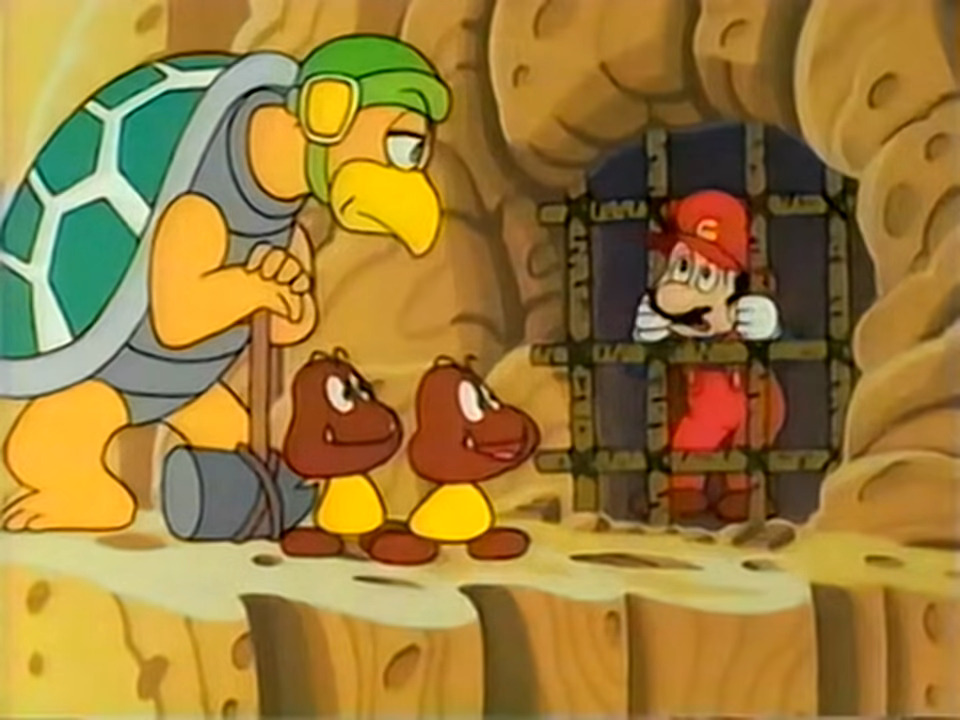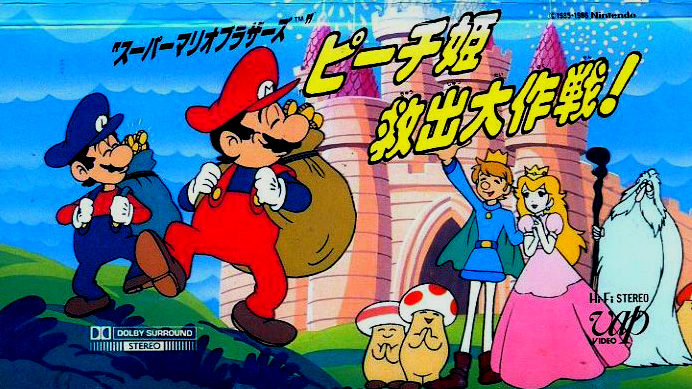As I’m sure you’ve all heard by now, Nintendo has partnered with Illumination Entertainment to produce an animated movie staring everybody’s favorite Italian-American-who-looks-like-a-Mexican plumber, Mario. Of course, given how well the Big N’s last film deal turned out, many fans are understandably anxious about Mario’s return to the big screen. Personally, I don’t think we have to worry about it turning out like 1993’s live-action bomb: that film was plagued with a very troubled production and an obscene number of rewrites that ultimately eroded the quality of the end product. I even wrote an article about the original—and much more faithful—screen play over a year ago.
Hmm…Why do I suddenly feel like I’m forgetting something…?
Oh cruft, that’s right! There’s already been an animated Super Mario Bros. movie! I guess I should talk about that, shouldn’t I?
Super Mario Bros.: Peach-Hime Kyushutsu Dai Sakusen!, or Super Mario Bros.: The Great Mission to Resuce Princess Peach if you’re feeling anglophonic, is an animated film released in Japanese theaters in 1986, making it the first ever theatrical feature based on a video game. It later received a limited release on VHS, copies of which are now quite hard to find.
So, does the adaptation from Mario’s homeland do him justice?
Plot Synopsis
The story begins in the midst of a scenario all too familiar to many of us: a late night game binge. Mario’s eyes are glued to his TV screen as he mashes buttons on a Famicom controller in the dark. Mario is so engrossed in his task that he doesn’t even acknowledge Luigi when the latter wishes him a good night. Shortly after Luigi retires, however, Mario’s game is interrupted with the image of a young woman being chased by monsters. Confused, he leans forward to take a closer look only for the woman to fly out of the screen and land on top of him. She’s immediately followed by a hoard of Bowser’s minions who flood out of the TV and into Mario’s living room. Shortly thereafter, Bowser shows up, incapacitates Mario, and takes Peach back into the television.
After they leave, Luigi wanders in to ascertain what all of the ruckus is about. Mario attempts to explain what just happened, but Luigi laughs it off and goes back to bed. As his brother leaves, Mario notices that the princess dropped something: a crystal amulet…because of course there’s an amulet!
Mario spends much of the next day daydreaming about the mysterious princess. His melancholy eventually begins to interfere his work as a grocer. Yeah, you read that right: a grocer. Seeing as Mario had been a plumber for only two or three games by this point and had previously held numerous blue-collar jobs beforehand, I can only assume they expected him to find another occupation in the next few days and were trying to predict what it would be. Regardless, Luigi eventually notices the amulet that Mario has been gazing at and identifies it as a special stone. Apparently, this stone has a twin and is magically drawn to it and, by extension, a land filled with untold riches. Hoping to use the stone to find Peach, Mario calls…uh, someone for more information. Who this person is isn’t exactly clear in any of the translations I could find, but the Mario Wiki claims it’s the author of the book Luigi read about the jewel in…yeah, let’s go with that. Anyway, the author tells Mario he’s coming by to pick him up. Shortly afterward, a deformed, blue Wiggler arrives. The brothers mistake it for a dog before the creature mugs Mario for the amulet and escapes, with Mario and Luigi giving chase.

Wait, Wigglers weren’t introduced until Super Mario World five years after this film released. Weird…
After a brief chase sequence through some pipes, the brothers fall into a portal to another world. When they come to, an old sage welcomes them the Mushroom Kingdom and proceeds to detail how Bowser’s sore that Peach turned down his marriage proposal and decided to wreck the Mushroom Kingdom in retaliation, and that the Mario brothers are the only ones that can put an end to the chaos. By this point, our heroes are a bit lost as to how they fit into all of this. The old man proceeds to recite a…*sigh*…prophesy in which…
Okay, no. I’m not letting this slide! The plot summary can wait; we need to talk about this!
PROPHESY?!
Okay, why does there always have to be a prophecy? Where did it come from? Who made it? How long has it been passed down? How do you know this incident is the one foretold in the prophecy? Does that mean our protagonists’ success is a done deal or is it just to help people identify who the heroes are? How many different interpretations are there? Is the exact meaning of the words a hotly debated topic among scholars and theologians? Do people learn ancient languages just to study the original text? Have there been religious schisms over this? Were people martyred? Have holy wars been fought over this?
Of course, all of these questions pale in comparison to the real issue: a prophecy runs contrary to who and what Mario is. Mario is a blue-collar hero: an everyman, someone the average person can relate to. In the original Super Mario Bros., destiny didn’t choose to make him a hero, he chose to be the hero himself. The vast majority of the time, Mario’s the hero by his own initiative. Mario represents how making a difference isn’t reserved to some special caste of people anointed by fate, it’s something even the unlikeliest of characters can do. Why is that never good enough for screenwriters?!
Mario represents how making a difference isn’t reserved to some special caste of people anointed by fate.
Deep breaths…okay, I’m good. Back to the plot synopsis.
Plot Synopsis (Continued)
The sage continues by telling Mario and Luigi that they’ll need to gather three magical items to defeat Bowser: a mushroom, a flower, and a star. The brothers then head on their way and the sage sends Kibidango, the odd, blue wiggler, to watch after them.
Later after a hard day full of walking montages, they camp for the night and Mario quickly falls asleep. Luigi, however, is famished. Hearing his plight, two passing goombas offer to lead Luigi to a mushroom grove. Unfortunately, the mushrooms in question happen to be a wee bit psychotropic. Mario (most likely in preparation for obtaining his medical license) attempts to use drugs to fix drugs by giving Luigi more mushrooms. Mario’s pharmacology is interrupted when he’s carried off by a giant koopa paratroopa and nearly fed to a nest full of baby birds. Luckily, he managed to hang onto some of the mushrooms and escapes being eaten by drugging the babies. After being reunited with Luigi and Kibidango, Mario spots the first treasure, the super mushroom, on top of the mountain and quickly climbs up to retrieve it. In the process, he restores some mushroom people who were transformed into gold coins and they give him the mountaintop treasure as thanks.
After another walking montage, the gang asks the goombas from earlier for directions, and are pointed in the direction of a flower field. Hoping to find the magical fire flower in the field, the brothers make a beeline for the flowers. Unfortunately, the flowers in question are actually piranha plants. After narrowly escaping the flesh-eating flowers, they run afoul of the Lakitu who tends the garden. Mario and co. are chased and eventually cornered by Lakitu’s army of spinies and only manage to escape via Deus ex Favus, which is to say a beanstalk springs out of nowhere, giving Mario enough height to tear off a chunk of the Lakitu’s cloud and chase him away. He then uses his bit of cloud to make it snow, thus putting the remaining spinies to sleep. His cloud chunk turns into another toad who rewards him with the fire flower.
Wait, the cloud was a toad? Isn’t that a bit morbid, transforming someone into an instrument of destruction (and a butt cushion)? Also, why wasn’t she ripped in half when Mario tore the cloud apart? The implications of this revelation are glossed over in favor of yet another walking montage in which Mario uses the fire flower to defeat a gang of buzzy…beetles? Are you fobbing kidding me?!
After the montage, the goombas from before use a trail of gold coins to lure the Mario brothers into a cave and where they are subsequently trapped. The goombas then reveal they were working for Bowser the whole time and leave the brothers in the care of a hammer brother.

Meanwhile in Bowser’s castle, Bowser’s trying to sweet talk Peach into going along with the wedding. It goes about as well as you’d expect. Peach then goads her captor into transforming himself (apparently he can do that) into various shapes saying it will cheer her up. Eager to please his bride, Bowser transforms until Peach asks him to transform into a teddy bear. Once he does so, she pulls a Puss in Boots and shoves him into a jewelry box and locks it. It ultimately doesn’t work, but I like how Peach isn’t completely passive during the whole ordeal.
Back with Mario, Luigi, and the ugliest wiggler, while Mario daydreams about dancing with Peach, Luigi continues to mine for gold, eventually digging his way out of the cave. After the brothers escape, Luigi realizes the gold he found in the cave was merely an illusion. Bereaved, he dumps the rocks into the ocean. As he does so, Mario notices among the stones the last item they need, the star. He dives in after it, is chased by a giant cheep-cheep, and eventually wrestles the star away from a giant clam. With the star in hand, Mario then raises a ship wreck by blowing into its sails while under water. This somehow manages to lift the ship into the air, and the team flies the ship toward Bowser’s castle as another musical interlude begins.
Funny—airships weren’t introduced to the series until 1988’s Super Mario Bros. 3.
By this point, the wedding is beginning. I actually really like the imagery used here. I don’t know if any of it was taken from Shinto or Buddhist wedding rituals or if it was made up for this scene, but it has an otherworldly, tribalistic air about it. Anyhoo, the proceedings begin and Bowser’s father (yes, he has a father) begins the ceremony. It doesn’t take long for Mario and company to crash the wedding. Bowser whisks Peach away to an inner chamber of the castle as Mario attempts to give chase. Luigi, channeling his inner D&D character, instead decides to search for loot.

Mario attempts to navigate the usual gauntlet of fireballs and lava pits, which proves to be a bit pointless as Luigi, in his eagerness to dig for gold, hits a water main which floods the lower levels of the castle thus compromising the building’s structural integrity and causing the building to collapse.
The final showdown between Mario and Bowser takes place in the ruins of the castle. Bowser has Mario on the run from the start, what with being 20 feet tall and able to breathe fire. Kibidango informs Mario that he needs to eat the three power-ups he collected. Mario swallows the mushroom and the flower, but gets distracted by a bag of snacks that literally appears out of nowhere before he can eat the star. Bowser knocks the star out of Mario’s hand, and Mario watches as it tumbles down a hole. Bowser gets ready to finish him off, but Peach pleads with the Koopa King to spare Mario, promising to marry him is he does. Bowser ain’t having any of it, however, as he knows sparing Mario will come back to bite him. Fortunately, the princess’ words distract Bowser long enough for Luigi, still searching for treasure, to burrow up in front of Mario and return the star. Mario manages to swallow the star just as Bowser stomps on him. The following fight is pretty one sided, as Mario uses his newfound strength to pummel Bowser, and eventually swing him by the tail and fling him into the distance.
I’d mention that wouldn’t happen in the games until 1996, but even The Super Mario Bros. Super Show managed to call that one, so no bonus points.
With Bowser gone, his spell upon the land is broken, flowers bloom, the mushroom people presumably return to normal off-screen, and Peach’s palace materializes out of thin air (I’m kind of desensitized to it by now). Mario takes this opportunity to return Peach’s necklace. She thanks him and then explains its significance: she’ll one day meet a prince with a matching necklace with whom she’ll fall in love. Mario quickly realizes he only had that one necklace, and promises to find the other. Just as he says this, however, the necklace starts to glow and Kibidango transforms from a disfigured wiggler into a dashing prince…wearing a matching necklace. He explains he is Prince Hal of the Flower Kingdom and Bowser transformed him into a dog (sic). Mario, though heartbroken, accepts the news with dignity. He and Luigi say their goodbyes and head home.
Review
The most obvious comparison to make to this film is The Super Mario Bros. Super Show. Not only are they both animated works from the 80’s, they feature some very similar visual elements, most notably the rocky, orange landscapes. That said, this movie trumps the Saturday-morning cartoon easily. I’d say the biggest difference is the quality of the animation. While it’s not entirely fair to compare a syndicated Saturday-morning cartoon to a feature film, the movie actually bothers to make the characters animated—by which I mean they emote and have exaggerated movements. The characters are expressive and move with a great sense of energy and weight that’s lacking from the American production, which in turn enables some good, Loony-Tunes-esque physical comedy. It also helps the characters of the film are rarely off-model compared to their in-game counterparts.

One strange thing to note, as you’ve no doubt gathered by now, is this movie seems to feature certain elements that would show up later in the games in future installments: the ability to steal Lakitu’s cloud, airships, Kibidango’s resemblance to wigglers, etc. I’d wager it’s mostly coincidental, but it still makes for a fun game to try to count all of the accidental predictions. Along that same line of thought, the plot brings to mind Mario’s latest outing, Super Mario Odyssey, what with its focus on a love triangle between Mario, Peach, and Bowser and the climax taking place during the latter two’s wedding. It’s a bit surreal to think this mostly forgotten movie has somehow managed to become more relevant with age.
So what do I think of it overall? For a kids’ film, I actually think it’s alright. It has some genuinely funny gags that feel reminiscent of the likes of Loony-Tunes and Merry-Melodies. I was especially surprised that many of the spoken jokes worked, considering that type of humor is notoriously difficult to localize.
I’m also a sucker for the “didn’t get the girl” trope. Love is such a cliched motive for characters in fiction that it’s always refreshing to see a deviation from the formula. Plus, I can appreciate the underlying message of accepting that even the best of people get shot down. That or I’ve just grown bitter over the years and am projecting my feelings onto a cartoon plumber.
With all of that said, this film isn’t without its faults. The movie’s short, with a run time of just barely one hour, and yet it still manages to fit in egregious amounts of padding. I’d say that without the multiple walking montages and mostly unnecessary musical interludes, this film would probably be only 45-50 minutes. Second are the non sequiturs: at points the movie literally pulls plot points out of thin air with no explanation. I don’t care if they try to play it off as a joke, it’s needlessly confusing.
While I wouldn’t call it a masterpiece, Super Mario Bros.: The Great Mission to Rescue Princess Peach is a fun film for fans of the series. If you’re not a fan of the games, however, I can’t recommend it as it really doesn’t hold much appeal outside of being a decent film adaptation of the games. That said, it is a decent adaptation, meaning that video game movies can at the very least be okay.
If you’d like to see it for yourself, you can find an excellent H.D. restoration here.
For a full podcast about Nintendo and their relationship with cinema, listen here.
Glen
Latest posts by Glen (see all)
- Goodbye, Two Button Crew - 12/28/2023
- TBC 40: The Legend of Zelda: Tears of the Kingdom - 12/27/2023
- TBC 039: Super Mario 64 - 09/28/2023



